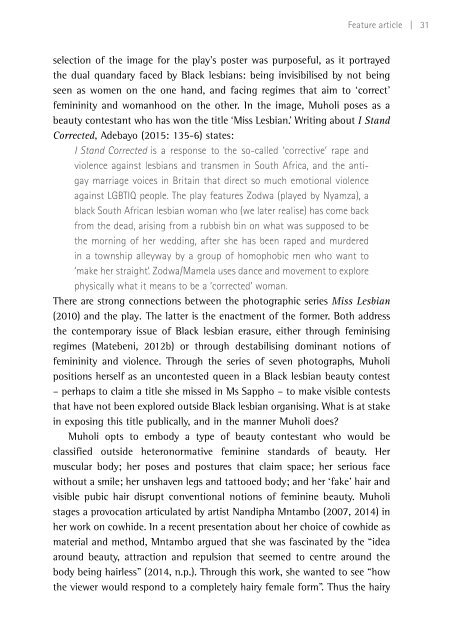The politics of fashion and beauty in Africa
fa21_proof_3
fa21_proof_3
Create successful ePaper yourself
Turn your PDF publications into a flip-book with our unique Google optimized e-Paper software.
Feature article | 31<br />
selection <strong>of</strong> the image for the play’s poster was purposeful, as it portrayed<br />
the dual qu<strong>and</strong>ary faced by Black lesbians: be<strong>in</strong>g <strong>in</strong>visibilised by not be<strong>in</strong>g<br />
seen as women on the one h<strong>and</strong>, <strong>and</strong> fac<strong>in</strong>g regimes that aim to ‘correct’<br />
fem<strong>in</strong><strong>in</strong>ity <strong>and</strong> womanhood on the other. In the image, Muholi poses as a<br />
<strong>beauty</strong> contestant who has won the title ‘Miss Lesbian.’ Writ<strong>in</strong>g about I St<strong>and</strong><br />
Corrected, Adebayo (2015: 135-6) states:<br />
I St<strong>and</strong> Corrected is a response to the so-called ‘corrective’ rape <strong>and</strong><br />
violence aga<strong>in</strong>st lesbians <strong>and</strong> transmen <strong>in</strong> South <strong>Africa</strong>, <strong>and</strong> the antigay<br />
marriage voices <strong>in</strong> Brita<strong>in</strong> that direct so much emotional violence<br />
aga<strong>in</strong>st LGBTIQ people. <strong>The</strong> play features Zodwa (played by Nyamza), a<br />
black South <strong>Africa</strong>n lesbian woman who (we later realise) has come back<br />
from the dead, aris<strong>in</strong>g from a rubbish b<strong>in</strong> on what was supposed to be<br />
the morn<strong>in</strong>g <strong>of</strong> her wedd<strong>in</strong>g, after she has been raped <strong>and</strong> murdered<br />
<strong>in</strong> a township alleyway by a group <strong>of</strong> homophobic men who want to<br />
‘make her straight’. Zodwa/Mamela uses dance <strong>and</strong> movement to explore<br />
physically what it means to be a ‘corrected’ woman.<br />
<strong>The</strong>re are strong connections between the photographic series Miss Lesbian<br />
(2010) <strong>and</strong> the play. <strong>The</strong> latter is the enactment <strong>of</strong> the former. Both address<br />
the contemporary issue <strong>of</strong> Black lesbian erasure, either through fem<strong>in</strong>is<strong>in</strong>g<br />
regimes (Matebeni, 2012b) or through destabilis<strong>in</strong>g dom<strong>in</strong>ant notions <strong>of</strong><br />
fem<strong>in</strong><strong>in</strong>ity <strong>and</strong> violence. Through the series <strong>of</strong> seven photographs, Muholi<br />
positions herself as an uncontested queen <strong>in</strong> a Black lesbian <strong>beauty</strong> contest<br />
– perhaps to claim a title she missed <strong>in</strong> Ms Sappho – to make visible contests<br />
that have not been explored outside Black lesbian organis<strong>in</strong>g. What is at stake<br />
<strong>in</strong> expos<strong>in</strong>g this title publically, <strong>and</strong> <strong>in</strong> the manner Muholi does?<br />
Muholi opts to embody a type <strong>of</strong> <strong>beauty</strong> contestant who would be<br />
classified outside heteronormative fem<strong>in</strong><strong>in</strong>e st<strong>and</strong>ards <strong>of</strong> <strong>beauty</strong>. Her<br />
muscular body; her poses <strong>and</strong> postures that claim space; her serious face<br />
without a smile; her unshaven legs <strong>and</strong> tattooed body; <strong>and</strong> her ‘fake’ hair <strong>and</strong><br />
visible pubic hair disrupt conventional notions <strong>of</strong> fem<strong>in</strong><strong>in</strong>e <strong>beauty</strong>. Muholi<br />
stages a provocation articulated by artist N<strong>and</strong>ipha Mntambo (2007, 2014) <strong>in</strong><br />
her work on cowhide. In a recent presentation about her choice <strong>of</strong> cowhide as<br />
material <strong>and</strong> method, Mntambo argued that she was fasc<strong>in</strong>ated by the “idea<br />
around <strong>beauty</strong>, attraction <strong>and</strong> repulsion that seemed to centre around the<br />
body be<strong>in</strong>g hairless” (2014, n.p.). Through this work, she wanted to see “how<br />
the viewer would respond to a completely hairy female form”. Thus the hairy



